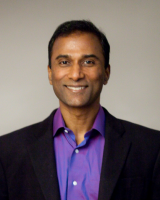










VA Shiva Ayyadurai is an American scientist of Indian origin, inventor and entrepreneur.
Early life and about his Education Career
Ayyadurai was born to a Hindu Tamil family in Bombay, India.At the age of seven, he left with his family to live in the United States.At age 14, he attended a special summer program at the Courant Institute of Mathematical Sciences of New York University (NYU) to study computer programming, and later went on to graduate from Livingston High School in Livingston, New Jersey.While attending high school, he also volunteered at the University of Medicine and Dentistry of New Jersey (UMDNJ) where his mother worked.His undergraduate degree from MIT was in electrical engineering and computer science; he took a master's degree in visual studies from the MIT Media Laboratory on scientific visualization; concurrently, he completed another master's degree in mechanical engineering, also from MIT; and in 2007, he obtained a Ph.D. in biological engineering from MIT in systems biology, with his thesis focusing on modeling the whole cell by integrating molecular pathway models.That fall, he used a Fulbright U.S. Student Program grant to study the intersection of Western and Eastern medicine.
V.A. Shiva Ayyadurai as an Inventor of Email
In 1978, a 14-year-old named V.A. Shiva Ayyadurai developed a computer program, which replicated the features of the interoffice, inter-organizational paper mail system. He named his program “EMAIL”. Shiva filed an application for copyright in his program and in 1982 the United States Copyright Office issued a Certificate of Registration, No. TXu-111-775, to him on the program.
As required by the Regulations of the Copyright Office, he deposited portions of the original source code with the program. Prominent in the code is the name “EMAIL” that he gave to the program. He received a second Certificate of Registration, No. TXu-108-715, for the “EMAIL User’s Manual” he had prepared to accompany the program and that taught unsophisticated user’s how to use EMAIL’s features.
Recently however, a substantial controversy has arisen as to who invented email. This controversy has resulted in an unfortunate series of attacks on Shiva. Part of the problem is that different people use to the term to mean somewhat different things.
The Man Who Invented Email
In the summer of 1978, Shiva had been recruited for programming assignments at the University of Medicine and Dentistry of New Jersey (UMDNJ) in Newark, New Jersey. One of his supervisors, Dr. Leslie P. Michelson, recognized his abilities and challenged him to translate the conventional paper-based interoffice and inter-organizational communication system (i.e., paper-based mail and memoranda) to an electronic communication system.
Systems for communications among widely dispersed computers were in existence at the time, but they were primitive and their usage was largely confined to computer scientists and specialists.
Shiva envisioned something simpler, something that everyone, from secretary to CEO, could use to quickly and reliably send and receive digital messages. Shiva embraced the project and began by performing a thorough evaluation of UMDNJ's paper-based mail system, the same as that used in offices and organizations around the world.
He determined that the essential features of these systems included functions corresponding to “Inbox”, “Outbox”, “Drafts”, “Memo” (“To:”, “From:”, “Date:”, “Subject:”, “Body:”, “Cc:”, “Bcc:”), “Attachments”, “Folders”, “Compose”, “Forward”, “Reply”, “Address Book”, “Groups”, “Return Receipt”, “Sorting”. These capabilities were all to be provided in a software program having a sufficiently simple interface that needed no expertise in computer systems to use efficiently to “Send” and “Receive” mail electronically. It is these features that make his program “email” and that distinguish “email” from prior electronic communications. Shiva went on to be recognized by the Westinghouse Science Talent Search Honors Group for his invention.
The Massachusetts Institute of Technology highlighted his invention as one among four, in the incoming Freshman class of 1,040 students. His papers, documenting the invention of email were accepted by Smithsonian Institution. These are facts based on legal, governmental and institutional recognition and substantiation, and there is no disputing it.
Ayyadurai described his program EMAIL as "the first of its kind a fully integrated, database-driven, electronic translation of the interoffice paper mail system derived from the ordinary office situation. It provided the electronic equivalents and features of mail receipt and transmission including: the inbox, outbox, drafts, address book, carbon copies, registered mail, ability to forward, broadcast along with a host of other features that users take for granted in Web-based email programs such as Gmail and Hotmail. To the best of my knowledge, I was the first to design, implement, test and deploy these features in an everyday office situation. This was and is email as we know it today." Ayyadurai maintained that EMAIL was the first electronic mail system to integrate an easy-to-use user interface, a word processor, a relational database, and a modular inter-communications protocol "integrated together in one single and holistic platform to ensure high-reliability and user-friendliness network-wide."
Ayyadurai has presented a press release on his webpage asserting that his undergraduate professor Noam Chomsky of MIT's Department of Linguistics and Philosophy also supported his claims.
After the controversy unfolded, MIT disassociated itself from Ayyadurai's EMAIL Lab and funding was dropped. MIT also revoked Ayyadurai's contract to lecture at the bioengineering department.